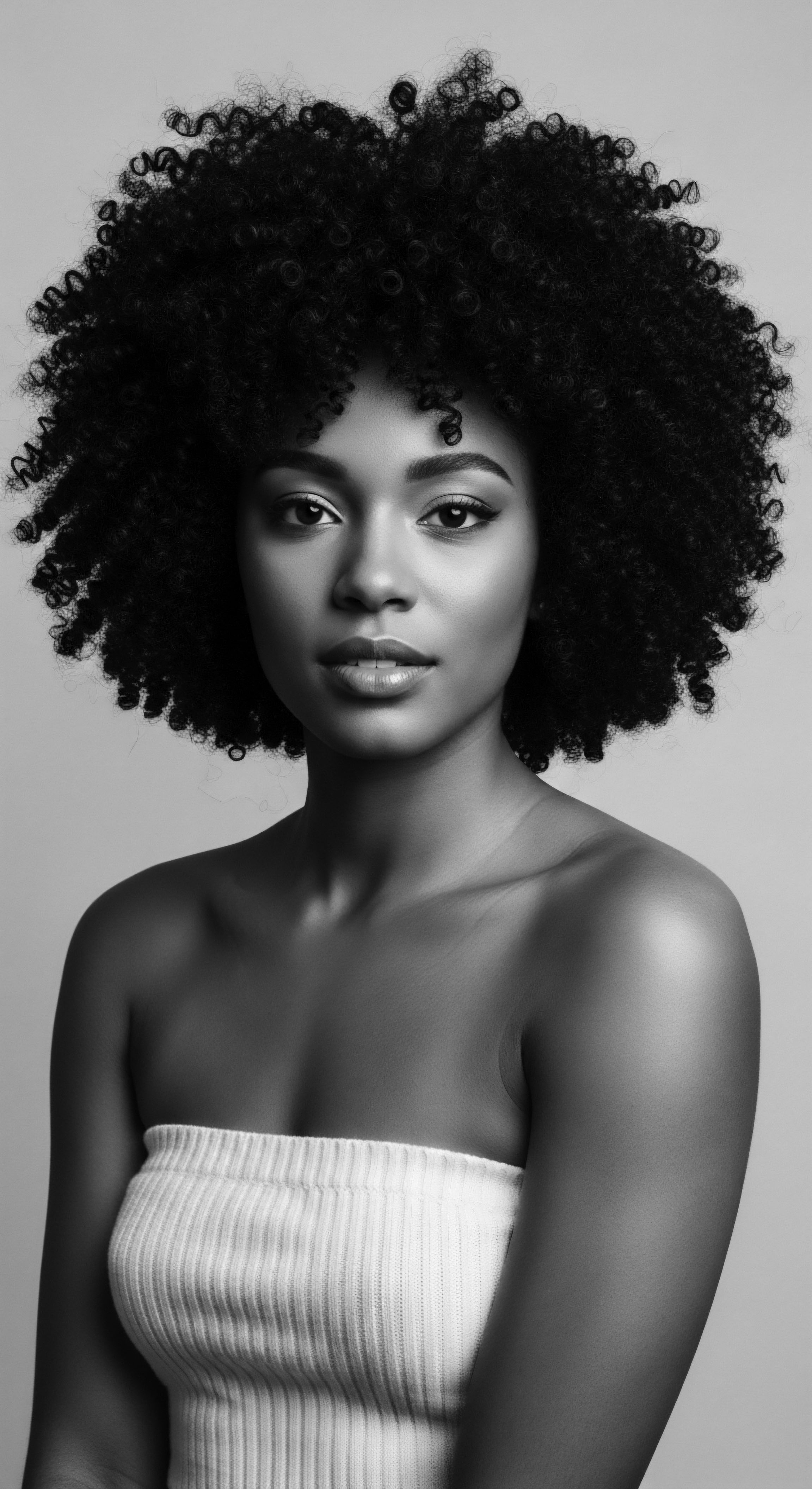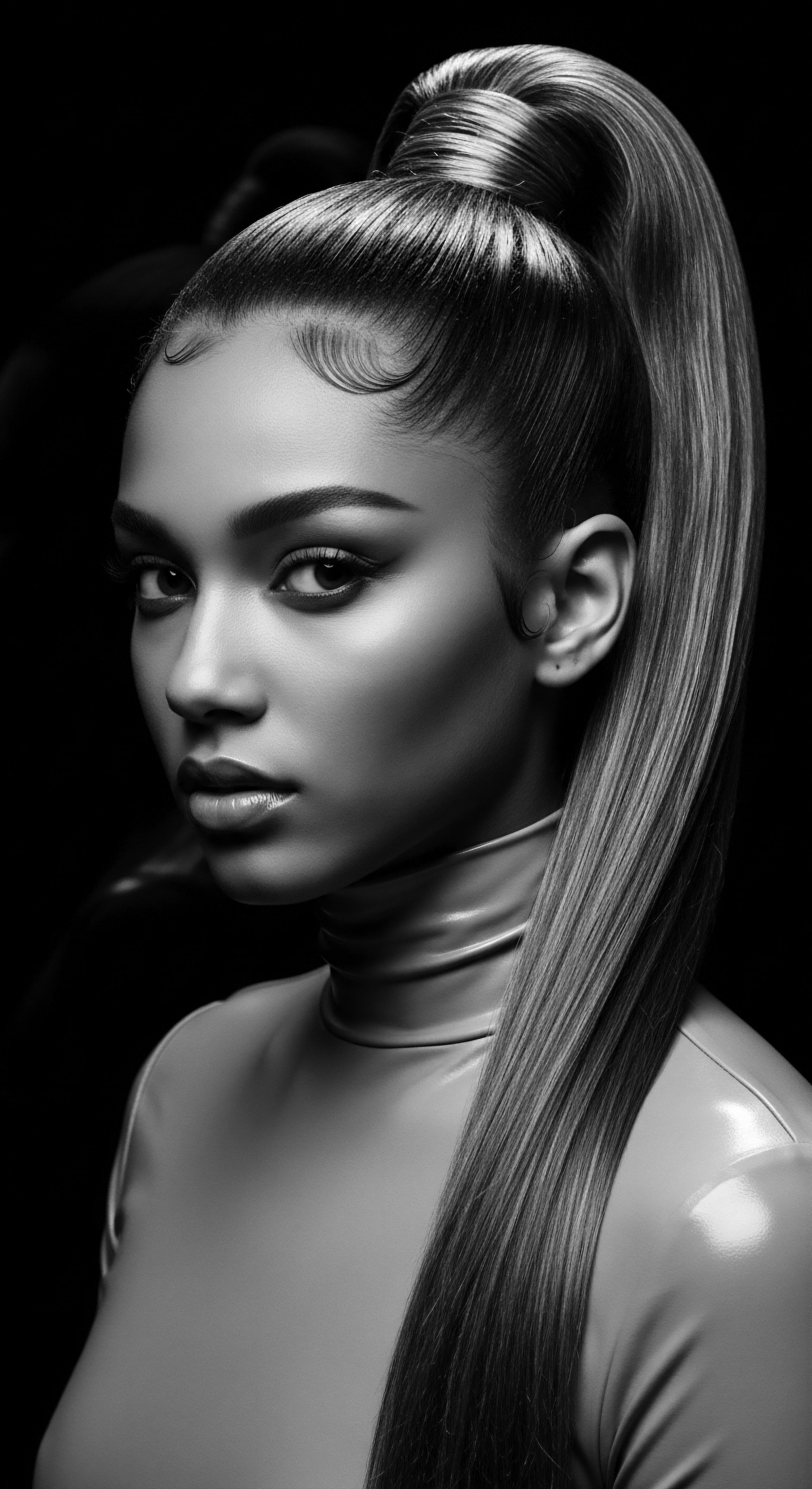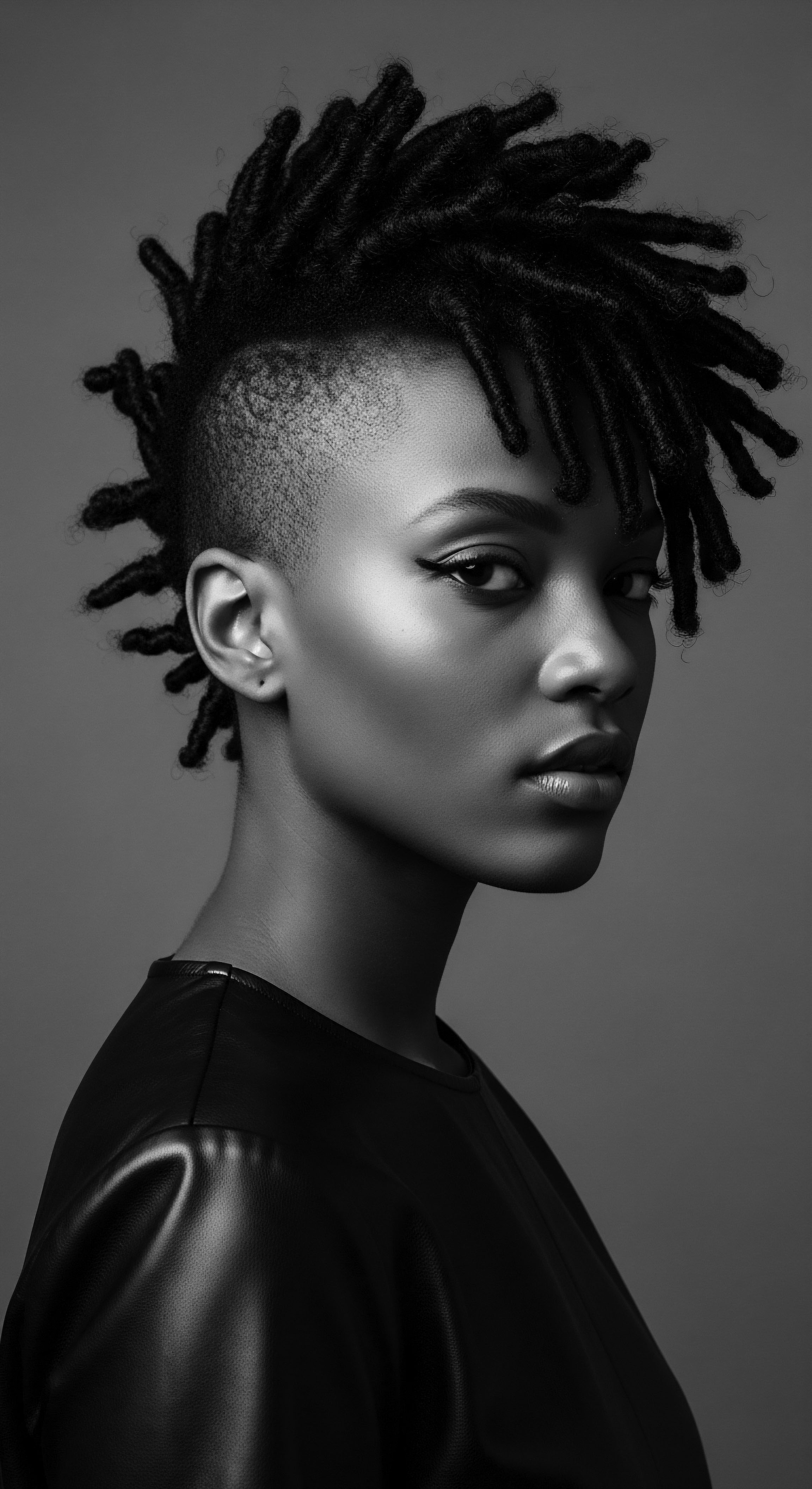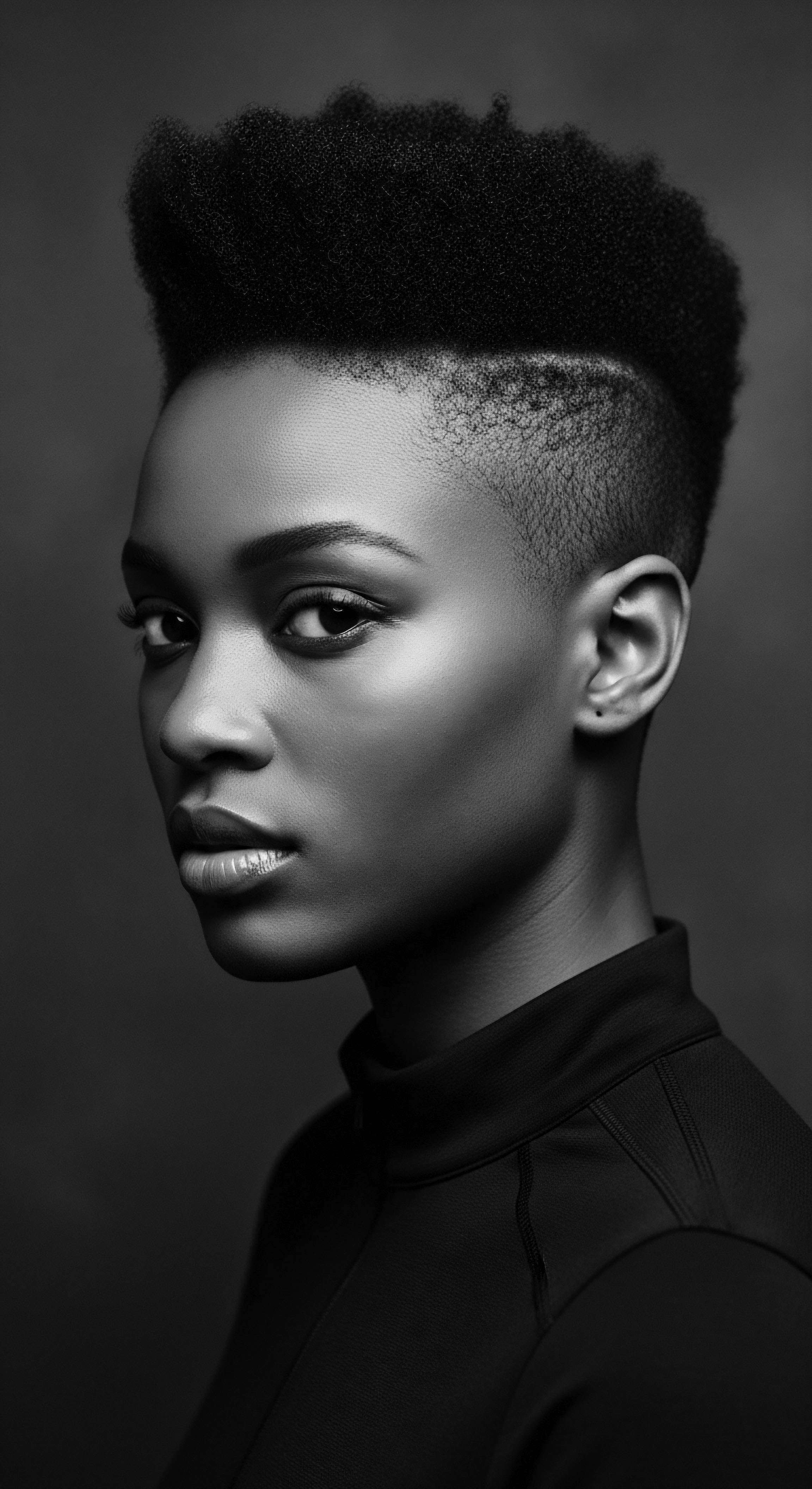
Roots
The story of textured hair, rich in its coils and waves, is a chronicle whispered through generations, a legacy bound to the very earth. For countless centuries, before the advent of modern chemistry, our ancestors turned to the botanical bounty around them, seeking solace, strength, and splendor for their crowns. These plant elements were not mere ingredients; they served as the fundamental building blocks of hair care, defining practices that spanned continents and echoed a profound connection to the natural world.
From the sun-baked savannas of West Africa to the lush Caribbean islands, plant life offered answers, shaping hair care into an art form, a ritual, and a vibrant expression of cultural identity. The lineage of textured hair care, in essence, commences with a deep respect for the botanical world.

What Did Ancient Hair Care Traditions Prioritize?
Ancient civilizations, particularly those in Africa, understood that healthy hair was a sign of well-being and social standing. The care regimen for textured hair was comprehensive, addressing cleansing, conditioning, and protection. This holistic approach was possible through an intimate knowledge of local flora. Plants provided emollients to keep hair soft, cleansers to maintain hygiene, and strengthening agents to minimize breakage.
It was a sophisticated system, relying on observation, inherited wisdom, and an understanding of the plant’s properties. In pre-colonial Africa, hair was a powerful medium of communication, with styles relaying messages about marital status, age, ethnic identity, wealth, and position within society. The intricate processes involved washing, oiling, and braiding, all rooted in community and spiritual connection.

How Did Plant Elements Form the Basis of Early Cleansing Rituals?
Long before commercial shampoos, plant elements were the primary agents for purifying hair and scalp. Saponin-Rich Plants, producing a natural lather when agitated with water, were widely employed. For example, in the Philippines, the bark of the Gugo Vine (Entada phaseoloides) served as a traditional shampoo, its lather gently cleansing the scalp and strands while offering anti-inflammatory properties. In various African communities, certain plant ashes were combined with oils to create a form of soap, offering both cleansing and conditioning.
Rhassoul clay, sourced from the Atlas Mountains of Morocco, represents another mineral earth element, rich in silica and magnesium, used for centuries to cleanse hair without stripping its vital moisture. This type of clay absorbs impurities and excess oil, leaving hair feeling soft and moisturized, a testament to ancient wisdom regarding delicate hair types. The careful application of such natural cleansers signifies a deep respect for hair’s natural balance.
Ancestral traditions laid the groundwork for textured hair care, relying on the land’s botanical gifts for cleansing, conditioning, and adornment.
Beyond simple cleansing, specific plant extracts were also applied for their medicinal qualities, addressing scalp ailments. Neem (Azadirachta indica), for instance, was valued in many parts of Africa and India for its antifungal and antibacterial properties, assisting in controlling dandruff and scalp irritation. This plant-based approach ensured that hygiene was always coupled with nourishment and healing, truly reflecting a holistic understanding of scalp and hair health.
The understanding of hair anatomy, while not articulated in modern scientific terms, was intrinsically linked to the efficacy of these natural applications. Ancestors observed that hair, particularly textured hair, required protection from environmental elements and retention of its natural moisture. This knowledge guided their selection of plant elements that offered protective coatings and humectant properties.
| Plant or Earth Element Gugo Vine (Entada phaseoloides) |
| Traditional Region of Use Philippines |
| Properties for Hair Care Natural lathering agent, anti-inflammatory properties for scalp health. |
| Plant or Earth Element Rhassoul Clay (Moroccan lava clay) |
| Traditional Region of Use North Africa (Morocco) |
| Properties for Hair Care Absorbs impurities, gentle cleansing, rich in minerals, moisturizes without stripping. |
| Plant or Earth Element African Black Soap (Shea butter, plant ash) |
| Traditional Region of Use West Africa |
| Properties for Hair Care Cleansing agent, often gentler than harsh soaps, contributes to moisture. |
| Plant or Earth Element These elements show a sophisticated ancestral approach to hair hygiene, balancing cleanliness with hair integrity. |
The wisdom of these early formulators, passed down through spoken traditions and shared practices, represents a profound botanical pharmacopoeia. They understood that every leaf, root, or seed held a potential benefit, waiting to be unlocked.

Ritual
The history of textured hair is also a history of artistry, of hands working with natural gifts to shape and adorn. Plant elements served as the essential materials for styling, defining the very contours of ancestral hair expressions. From maintaining the crispness of braids to the softness of coils, these botanicals provided the texture, hold, and sheen that characterized historical hair designs. The application of plant-based preparations transformed simple acts of grooming into profound community rituals, often taking hours or even days, strengthening communal bonds and passing down heritage.

How Did Plant-Based Lubricants and Softeners Influence Styling?
The unique structure of textured hair often requires ample moisture and lubrication to permit manipulation without breakage. Ancestral communities discovered early on that certain plant oils and butters provided the necessary slip and softness for styling. Shea Butter (Vitellaria paradoxa), sourced from the nuts of the shea tree, stands as a prime example.
It was, and remains, a cornerstone of West African hair care, widely used for its emollient properties that moisturize and protect hair from harsh environmental conditions. This natural fat provided the slip needed for intricate braiding, twisting, and coiling, minimizing friction and breakage, allowing for styles that could last for extended periods.
Similarly, Castor Oil (Ricinus communis), particularly the traditionally prepared Jamaican Black Castor Oil (JBCO) , holds a special position in diasporic hair heritage. The traditional process of roasting castor beans before pressing, sometimes incorporating ash from burnt coconut shells or sugarcane, lends JBCO its characteristic dark color and higher alkalinity. This alkaline property was believed to assist in opening the hair cuticle, allowing the oil’s ricinoleic acid to deeply condition and strengthen hair.
JBCO became a fundamental element for promoting healthy hair growth and maintaining strength, particularly among Afro-Caribbean communities. Its application was often a shared moment, a time for stories and connection, weaving ancestral wisdom into the strands.
Plant oils and butters were not just conditioners; they were tools for artistic expression, enabling the creation of intricate styles and embodying community spirit.

What Role Did Plants Play in Hair Adornment and Longevity of Styles?
Beyond conditioning, plants were used for enhancing the aesthetic appeal and durability of hairstyles. Natural waxes, such as those derived from certain plants, provided hold and shine, keeping elaborate styles intact. The historical significance of Chebe powder, from the Basara Arab women of Chad, offers another fascinating instance. This traditional remedy, a blend of various herbs, seeds, and plants, was used to coat and protect hair, helping to retain length by preventing breakage and sealing in moisture.
Though it did not stimulate hair growth from the scalp, its consistent application protected the hair shaft, reducing split ends and improving elasticity, thereby allowing natural hair to grow longer over time without breaking. The ritual of applying Chebe, often mixed with oils or butters and braided into sections, was deeply rooted in community, beauty, and cultural identity.
Moreover, plant-based dyes, like Henna (Lawsonia inermis), originating from ancient civilizations and used across North Africa, the Middle East, and India, offered not only color but also conditioning benefits. Henna coats the hair shaft, providing a protective layer that can improve the hair’s overall resilience and shine. While often linked to color, its conditioning properties were significant for textured hair, which benefits from external protection. These practices reflect a deep understanding of botanical chemistry, even if not articulated in modern scientific terms, demonstrating how ancestral ingenuity utilized natural resources to maintain and beautify hair.
- Shea Butter ❉ A rich emollient sourced from the shea tree, historically crucial for moisturizing and preparing textured hair for styling.
- Jamaican Black Castor Oil ❉ A specially prepared oil, historically used in Afro-Caribbean heritage, known for its ability to strengthen hair and promote healthy growth.
- Chebe Powder ❉ A Chadian blend of herbs and seeds, traditionally applied to prevent breakage and aid length retention in textured hair.
| Plant Element Shea Butter |
| Primary Function in Styling Moisturizer, lubricant for manipulation |
| Cultural Context West African, widespread in diaspora; vital for braiding and twisting ease. |
| Plant Element Jamaican Black Castor Oil |
| Primary Function in Styling Strengthening, promoting growth, providing shine |
| Cultural Context Afro-Caribbean heritage; central to ancestral hair care routines. |
| Plant Element Chebe Powder |
| Primary Function in Styling Protection, length retention, sealing |
| Cultural Context Basara Arab women of Chad; part of communal hair care rituals. |
| Plant Element These botanical resources enabled ancestral communities to create and maintain intricate hairstyles, embodying cultural identity. |
The utilization of these elements was not random; it was a deeply ingrained system of knowledge passed from elder to youth, a living archive of hair mastery. The hands that prepared the butter or mixed the powders understood the very feel of textured strands, knowing precisely what was needed for optimal manageability and beauty.

Relay
The deeper exploration of plant elements in textured hair practices reveals not just a collection of ingredients, but a sophisticated understanding of holistic well-being, deeply woven into ancestral wisdom. These elements were central to daily regimens, nighttime customs, and the resolution of hair challenges, all viewed through a lens of inherited knowledge and cultural continuity. The enduring value of these botanical assets stands as a testament to ingenuity and a profound connection to the earth’s offerings.

Did Ancestral Regimens Include Specific Nighttime Care with Plants?
While explicit “nighttime rituals” as a distinct category might not be detailed in historical texts in the same way modern beauty industries describe them, the continuous application of plant-based emollients and protective styling naturally extended into overnight care. After days of activity, hair would have been re-moisturized and styled in ways that minimized tangling and maintained integrity, often with plant-derived components. For instance, the regular application of Shea Butter or various plant oils during the day meant that hair went into the night nourished, likely then covered with fabrics to prevent moisture loss and friction. This form of “sleep protection” is an ancestral practice, predating modern bonnets, relying on natural materials and consistent conditioning with elements like palm oil or Almond Oil, which were prized for their moisturizing capabilities in ancient Egypt.
The understanding that hair needs consistent hydration and protection, particularly for textured hair prone to dryness, is ancient. Many African communities incorporated regular oiling into their routines, which would have carried over into the night, protecting strands as individuals rested. This continuous care prevented the very issues that modern nighttime routines aim to combat—dryness, breakage, and tangles. It was a fluid, adaptive system where daily applications served an extended purpose, a rhythm of care that honored the delicate nature of coils and curls.

How Were Plant Elements Employed for Hair Challenges and Wellness?
Beyond daily maintenance, plant elements were the ancestral pharmacopoeia for addressing specific hair and scalp challenges. Hair loss, dandruff, and scalp irritation were not new issues, and communities relied on the inherent properties of local flora to provide solutions. An ethnobotanical survey in Afar, Northeastern Ethiopia, for example, identified 17 plant species used for hair and skin care, with high agreement among informants regarding their uses.
Ziziphus Spina-Christi and Sesamum Orientale were among the preferred species, often used as topical hair treatments or cleansing agents. This regional insight highlights the localized knowledge systems that developed around specific botanical resources.
Another compelling instance lies in the widespread use of plants with antiseptic or soothing properties. Aloe Vera (Aloe barbadensis miller), recognized across many cultures for its healing attributes, would have been used for scalp conditions, its gel offering relief from irritation and assisting in moisture retention. In some African traditions, certain plant leaves or roots were crushed and applied as poultices to treat scalp ailments, demonstrating an intuitive grasp of botanical medicine for dermatological health. The integration of such remedies reflects a wellness philosophy where the body and hair were considered an interconnected system, sustained by natural elements.
Consider the broader impact of nutritional plants on hair health. While not applied topically, the consumption of certain plants rich in vitamins and minerals would have contributed to overall well-being, subsequently impacting hair strength and growth. This dietary aspect forms an unseen, yet vital, component of holistic hair care, linking internal health directly to the vitality of the hair. This tradition continues to inform contemporary wellness practices, where diet is acknowledged as a foundational element for hair resilience.
Plant elements were woven into daily life and nocturnal practices, offering both preventative care and ancestral remedies for hair and scalp issues.
The profound impact of plant elements on historical textured hair practices cannot be overstated. These natural gifts were not merely functional; they were intrinsically linked to cultural ceremonies, expressions of identity, and the preservation of heritage. The continuity of their use, even in modern times, speaks to their enduring efficacy and the wisdom embedded in ancestral ways.
- Castor Bean ❉ Historically processed into oils to strengthen hair and eyelashes, particularly noted in Jamaican and Haitian traditions.
- Aloe Vera ❉ Valued for its moisturizing and soothing properties, used across various cultures for scalp health and conditioning.
- Hibiscus (Hibiscus sabdariffa) ❉ Employed for its conditioning properties and ability to nourish hair roots, often found in traditional remedies.
| Plant Element Neem (Azadirachta indica) |
| Traditional Use for Hair Challenge Dandruff, scalp infections, anti-lice |
| Modern Scientific Correlation Antifungal, antibacterial properties support scalp health. |
| Plant Element Fenugreek (Trigonella foenum-graecum) |
| Traditional Use for Hair Challenge Hair cleansing, promoting hair growth |
| Modern Scientific Correlation Contains compounds with potential for scalp circulation and hair follicle stimulation. |
| Plant Element Moringa (Moringa oleifera) |
| Traditional Use for Hair Challenge Hair nourishment, general care |
| Modern Scientific Correlation Rich in vitamins and minerals, supporting overall hair vitality. |
| Plant Element These botanical remedies display an intuitive understanding of hair biology and an enduring commitment to natural solutions. |
The wisdom of using plant elements for a full spectrum of hair needs—from daily care to addressing specific complaints—underscores a philosophy where health and beauty were inextricably linked to the gifts of the earth. This living archive of knowledge continues to inform contemporary approaches to textured hair, reminding us of the deep well of ancestral ingenuity.

Reflection
The exploration of plant elements that defined historical textured hair practices brings us to a quiet understanding of heritage, a deep appreciation for the hands that cultivated, prepared, and applied these gifts from the earth. The very fiber of textured hair, with its unique structure and intrinsic needs, found its most profound allies in the botanical world. From the communal act of processing shea butter to the careful application of a castor oil treatment, each interaction with a plant element was not just about physical care; it was a reaffirmation of identity, a link to ancestral wisdom, and a living demonstration of resilience.
These ancient practices, far from being relics of a distant past, continue to whisper their lessons to us. They speak of sustainability, of working in harmony with nature, and of finding remedies within our immediate surroundings. They remind us that true care extends beyond superficial beauty, reaching into the well-being of the scalp, the strength of the strand, and the spirit of the individual.
The legacy of plant-defined hair care is a continuous current, flowing from ancient rivers to modern washes, a timeless testament to how our forebears honored their crowns and passed down knowledge that defies time. It is a heritage that invites us to listen to the soul of each strand, to understand its history, and to respect the elemental connection that binds us to the earth and to one another.

References
- Safic-Alcan. Hair Care through the ages ❉ Inspired by the past, Designed for the future.
- Kreyol Essence. Black Castor Oil vs. Castor Oil ❉ Key Differences. 2025.
- Dube, M. et al. What Every Dermatologist Must Know About the History of Black Hair. Cutis. 2023.
- Hera Head Spa. What Benefits Can Botanical Hair Spa Offer to My Hair and Scalms Healt. 2024.
- Ambuja Solvex. Jamaican Black Castor Oil ❉ Surprising Benefits & Facts. 2022.
- FullyVital. Emollient ❉ The Key to Nourished and Healthy Hair. 2023.
- Singh, S. et al. Botanical Medicinal Oils for Hair Care and Scalp Health. Asian Journal of Research in Pharmaceutical Sciences. 2023.
- Holy Natural. Jamaican Black Castor Oil for Hair Growth. 2022.
- Jain, S. & Jain, R. Studies on Traditional Herbal Cosmetics Used by Tribal Women in District Jaipur (Rajasthan). Journal of Ethnopharmacology. 2017.
- Beauty of Africa Hair. The History of Chebe Powder ❉ An Ancient African Hair Secret for Hair Growth. 2025.
- Miraco Beauty. Unlocking Ancient African Beauty Traditions ❉ A Tribute to Black History Month with Timeless Indigenous Ingredients for Radiant Skin and Hair. 2024.
- 22 Ayur. The Ancient Natural Ways of Hair Care Across Continents.
- Vogue Philippines. ‘Gugo,’ The Ancient Filipino Hair Care Ingredient. 2023.
- Ghasemi, M. R. et al. Hair Oils ❉ Indigenous Knowledge Revisited. Pharmacognosy Reviews. 2017.
- Mapoure, Y. B. et al. Cosmetopoeia of African Plants in Hair Treatment and Care ❉ Topical Nutrition and the Antidiabetic Connection? MDPI. 2023.
- GSC Online Press. Phytochemicals in Hair Care ❉ A Review of Natural Ingredients and Their Applications. 2024.
- Obscure Histories. Ancient Gems ❉ A Historical Survey of African Beauty Techniques. 2024.
- Sellox Blog. Ancient African Hair Growth Secrets For Healthy Hair. 2021.
- Abeykoon, D. et al. Cosmetic Ethnobotanical Applications for Hair Care. ResearchGate. 2025.
- Amazon. Holy Natural – The Wonder of World Jamaican Black Castor Oil.
- Hues Salon & Wellness. Botanical Repair – hues-salon-&-wellness. 2025.
- Heritage Store. Black Castor Oil for Hair.
- Botanica.africa. Plant Extracts for Personal Care Applications. 2021.
- La Pearl Beauty Emporium Inc. Get Gorgeous Hair with Herbal Botanical Products. 2024.
- Colleen. The History of Textured Hair. 2020.
- Mohammad, M. R. et al. History of Natural Ingredients in Cosmetics. Cosmetics. 2021.
- Abegaz, A. et al. Plants used for hair and skin health care by local communities of Afar, Northeastern Ethiopia. Ethnobotany Research and Applications. 2025.
- Bebrų Kosmetika. Traditional Beauty Secrets of Sub-Saharan Africa.
- El Hadj, A. et al. Ethnobotanical Survey of Medicinal Plants used in the Treatment and Care of Hair in Karia ba Mohamed (Northern Morocco). ResearchGate. 2024.
- Shea Radiance. Using Shea Butter on Hair | Different Ways to Apply Shea Butter. 2022.
- Organic Only. Organic Shea Butter from Ghana.
- El Hadj, A. et al. Original Article Ethnobotanical Survey of Medicinal Plants used in the Treatment and Care of Hair in Karia ba Mohamed (Northern Morocco). ResearchGate. 2024.
- E3S Web of Conferences. Ethnobotanical survey of medicinal plants used in cosmetics in Ketama (North of Morocco).
- BLAM UK CIC. The history of Black Hair. 2022.
- Bebrų Kosmetika. The Power of Hair in African Folklore ❉ Rituals and Traditions. 2024.
- UL Prospector. Natural Based Emollients ❉ Imparting Moisture Without Chemicals. 2016.
- Cosmopolitan. Shea Butter for Hair ❉ 8 Best Products, DIYS, and How to Use It. 2022.
- WOWnature. How is shea butter used. 2024.
- ELLE. A Brief History Of Black Hair Rituals. 2020.
- Nuevo Noir. The history of Afro hair. 2024.
- Mapoure, Y. B. et al. Cosmetopoeia of African Plants in Hair Treatment and Care ❉ Topical Nutrition and the Antidiabetic Connection? ResearchGate. 2024.
- Jaradat, N. et al. Ethnopharmacological survey of home remedies used for treatment of hair and scalp and their methods of preparation in the West Bank-Palestine. PubMed Central. 2017.
- Bardolph, D. N. An Archaeobotanical Approach to Well-Being ❉ Enslaved Plant Use at Estate Cane Garden, 19th Century St. Croix. 2020.
- SAS Publishers. Plants Use in the Care and Management of Afro-Textured Hair ❉ A Survey of 100 Participants. 2023.
- Aveda. Living Aveda Blog – The Plant Power of Botanical Repair. 2025.
